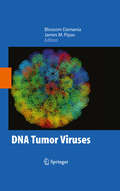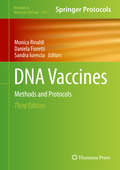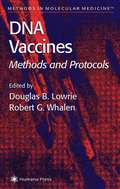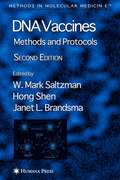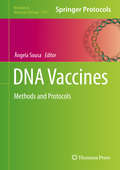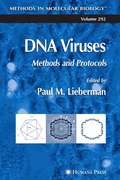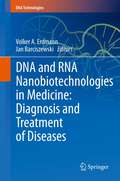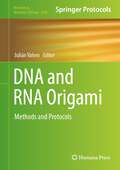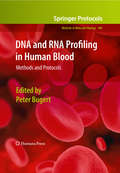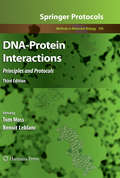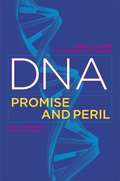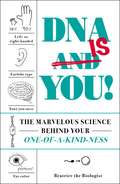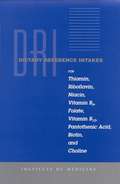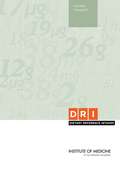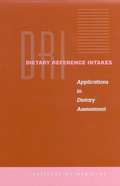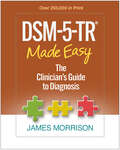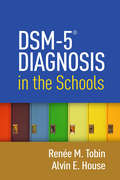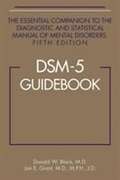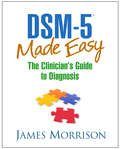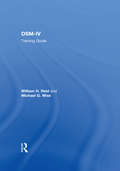- Table View
- List View
DNA Tumor Viruses
by James Pipas Blossom DamaniaThis unique book focuses on the DNA viruses in the human population that are associated with cancers. It covers most of the viruses that are thought to contribute to human malignancy. This book represents a comprehensive review of the field of DNA tumor virology. Right now, while there are books out there that cover individual viruses that are also covered in this book, there is no single book that covers this topic comprehensively. This book is the first current, comprehensive review of its kind in the market.
DNA Vaccines
by Monica Rinaldi Daniela Fioretti Sandra IuresciaDNA Vaccines: Methods and Protocols, Third Edition explores innovative approaches and technologies used to design, deliver, and enhance the efficacy of DNA vaccines. Featuring applications which should be of great value in moving vaccines from research to clinic, this detailed volume includes sections on DNA vaccine design and enhancement, delivery systems, production, purification, and quality, as well as chapters on new vaccine applications. Written in the highly successful Methods in Molecular Biology series format, chapters contain introductions their respective topics, lists of the necessary materials and reagents, step-by-step, readily reproducible laboratory protocols, and tips on troubleshooting and avoiding known pitfalls. Authoritative and practical, DNA Vaccines: Methods and Protocols, Third Edition serves the important role of further documenting the potential of the DNA vaccination as a platform technology for treatment and prevention of human disease.
DNA Vaccines
by Douglas B. Lowrie Robert WhalenState-of-the-art review articles by leading experts summarize how to develop and employ the highly promising new DNA vaccines, what clinical results can be expected from their use, and what is known about how they work. Key topics range from vaccine design and construction to preparation and delivery methods, including the use of classical adjuvants, "genetic adjuvants," and the immunostimulatory properties of DNA and selected oligonucleotide sequences. Several contributors provide strategic ideas on antigen engineering and describe the novel applications of DNA vaccine methodology that have recently emerged. Cutting-edge and comprehensive, DNA Vaccines: Methods and Protocols provides a snapshot of the methods and thinking from which the vaccines of tomorrow will evolve.
DNA Vaccines
by Mark W. Saltzman Hong Shen Janet L. BrandsmaIn this completely revised and updated second edition of DNA Vaccines: Methods and Protocols, W. Mark Saltzman presents a comprehensive collection of DNA vaccine protocols, written by leading experts in the groundbreaking field of DNA vaccination. Divided into five sections, this volume contains state-of-the-art and practical procedures on the latest DNA vaccine technology. Part I contains DNA vaccine design protocols, focusing on methods that achieve optimal expression in host cells. Part II is dedicated to presenting methods for DNA delivery, and covers both the range of administration methods available for vaccine administration and a variety of techniques for improving the efficiency of delivery into cells. Part III discusses current available methods, including adjuvant and prime-boost approaches, for enhancing the potency of DNA vaccines. Part IV describes several key areas of application in the field, including allergy, avoidance of autoimmunity, and neonate and infant vaccine response. DNA Vaccines: Methods and Protocols, Second Edition concludes with a review of protocols for vaccine production and purification, and applicable quality control methods. This collection of up-to-date protocols demonstrates the tremendous progress that has been made in the field of DNA vaccination since the initial appearance of this new vaccination strategy. Given current enthusiasm for the magnificent potential for this technology among the scientific community, researchers will find tremendous value in this updated and enhanced molecular methods guide.
DNA Vaccines: Methods and Protocols (Methods in Molecular Biology #2197)
by Ângela SousaThis volume details practical procedures on the latest DNA vaccine technology. Chapters guide readers through methods and protocols on DNA vaccine design, the adjuvant influence, production and purification methodologies, delivery systems, and approaches of the influence of DNA vaccines in the immunological response performance and in the cancer immunotherapy. Written in the highly successful Methods in Molecular Biology series format, chapters include introductions to their respective topics, lists of the necessary materials and reagents, step-by-step, readily reproducible laboratory protocols, and tips on troubleshooting and avoiding known pitfalls. Authoritative and cutting-edge, DNA Vaccines: Methods and Protocols aims to ensure successful results in the further study of this vital field.
DNA Viruses
by Paul M. LiebermanA compendium of readily reproducible and novel methods to manipulate DNA viruses and characterize their varied biological properties. The authors emphasize techniques for viral detection and genetics, but also include methods for structure determination, gene expression, replication, pathogenesis, complex cellular models, recombinant genetics, and computational/systems approaches. Wide-ranging and highly practical, DNA Viruses: Methods and Protocols will stimulate new directions in virology research with its novel strategies for engineering viral vectors in gene therapy, and its advanced approaches for detecting viruses in human disease.
DNA and RNA Nanobiotechnologies in Medicine: Diagnosis and Treatment of Diseases
by Jan Barciszewski Volker A. ErdmannThis book will provide latest insights in the functional potentials of ribonucleic acids in medine and the use of Spiegelmer and Spiegelzyme systems. It will also deal with a new type of delivery systems for cellular targeting.
DNA and RNA Nanobiotechnologies in Medicine: Diagnosis and Treatment of Diseases (RNA Technologies)
by Volker A. Erdmann and Jan BarciszewskiThis book will provide latest insights in the functional potentials of ribonucleic acids in medine and the use of Spiegelmer and Spiegelzyme systems. It will also deal with a new type of delivery systems for cellular targeting.
DNA and RNA Origami: Methods and Protocols (Methods in Molecular Biology #2639)
by Julián ValeroThis volume detials diverse methodological approaches on the assembly and applications of DNA origami assemblies. Chapters guide readers through different synthetic and computational methods, isolation and structural characterization of 2D and 3D DNA origami nanoarchitectures, nanophotonics, drug delivery, biophysics, and synthetic biology.Written in the successful Methods in Molecular Biology series format, chapters include introductions to their respective topics, lists of the necessary materials and reagents, step-by-step, readily reproducible protocols, and notes on troubleshooting and avoiding known pitfalls. Authoritative and cutting-edge, DNA and RNA Origami: Methods and Protocols aims to serve as a guideline describing the current state-of-the-art assembly methodologies and applications of DNA origami nanostructures.
DNA and RNA Profiling in Human Blood
by Peter BugertBlood samples have consistently proven to be a key source of genetic material for a wide variety of diagnostic or research purposes. In DNA and RNA Profiling in Human Blood: Methods and Protocols, leading international experts contribute both established and recently developed protocols for complex and high-throughput DNA and RNA profiling. Divided into two thorough sections, the volume concentrates on DNA profiling for blood cell antigens through methods on high-throughput multiplex approaches and SNP typing, along with RNA profiling in blood cells addressing certain blood cell types such as platelets, reticulocytes, and megakaryocytes. Written in the highly successful Methods in Molecular BiologyTM series format, all of the chapters include brief introductions on the subject, lists of the necessary materials and reagents, step-by-step, readily reproducible laboratory protocols, as well as the Notes section which highlights tips on troubleshooting and avoiding known pitfalls. Authoritative and cutting-edge, DNA and RNA Profiling in Human Blood: Methods and Protocols is an ideal guide to the molecular profiling approaches that have opened up this broad field of research and have shown great promise in the further identifying of disease markers in blood.
DNA, Race, and Reproduction
by Emily Klancher Merchant and Meaghan O’KeefeA free ebook version of this title is available through Luminos, University of California Press's Open Access publishing program. Visit www.luminosoa.org to learn more.DNA, Race, and Reproduction helps readers inside and outside of academia evaluate and engage with the current genomic landscape. It brings together expertise in law, medicine, religion, history, anthropology, philosophy, and genetics to examine how scientists, medical professionals, and laypeople use genomic concepts to construct racial identity and make or advise reproductive decisions, often at the same moment. It critically and accessibly interrogates how DNA figures in the reproduction of racialized bodies and the racialization of reproduction and examines the privileged position from which genomic knowledge claims to speak about human bodies, societies, and activities. The volume begins from the premise that reproduction, regardless of the means, forces a confrontation between biomedical, scientific, and popular understandings of genetics, and that those understandings are often racialized. It therefore centers reproduction as both a site of analysis and an analytic lens.
DNA-Protein Interactions
by Tom Moss Benoît LeblancGene expression can mean the difference between a functional and non-functional genome, between health and disease, and with the development of transgenic crops, the difference between survival and starvation. In DNA-Protein Interactions: Principles and Protocols, Third Edition, this vital subject is brought up to date with protocols exploring the most cutting-edge developments in the field, including in vivo and genome-wide interaction techniques. Addressing topics such as chromatin immunoprecipitation, topological studies, photocrosslinking, FRET and imaging techniques, the volume fully updates and expands upon the successful previous editions. Written in the convenient and informative Methods in Molecular BiologyTM series format, chapters include introductions to their respective subjects, lists of the necessary materials and reagents, step-by-step, readily reproducible laboratory protocols, and notes on troubleshooting and avoiding known pitfalls. Comprehensive and authoritative, DNA-Protein Interactions: Principles and Protocols, Third Edition serves as an ideal guide for all those exploring this dynamic, essential, and increasingly affordable area of research.
DNA: Promise and Peril
by Linda L. Mccabe Edward R. B. MccabeThis book gives the background information critical to understanding how genetics is now affecting our everyday lives. It gives a comprehensive view of exciting recent discoveries and explores the ethical, legal, and social issues that have arisen with each new development.
DNA: The Story of the Genetic Revolution
by James D. Watson Andrew Berry Kevin DaviesThe definitive insider's history of the genetic revolution--significantly updated to reflect the discoveries of the last decade. James D. Watson, the Nobel laureate whose pioneering work helped unlock the mystery of DNA's structure, charts the greatest scientific journey of our time, from the discovery of the double helix to today's controversies to what the future may hold. Updated to include new findings in gene editing, epigenetics, agricultural chemistry, as well as two entirely new chapters on personal genomics and cancer research. This is the most comprehensive and authoritative exploration of DNA's impact--practical, social, and ethical--on our society and our world.
DNA Is You!: The Marvelous Science Behind Your One-of-a-Kind-ness
by Beatrice The BiologistLearn all about how your DNA makes you who you are—an awesome, unique individual—in this fun and simple illustrated guide! Did you know your sense of purpose is determined by your genes? And that DNA determines your reaction to poison ivy, and maybe even your sex drive? In DNA Is You!, the author behind Beatrice the Biologist uses her trademark humor to break down the ins and outs of DNA to give you the low-down on each trait, one by one. She provides the answers to questions like: how dependent are traits on your parents’ genes? Are they based on mutations or influenced by the environment? What kind of studies have been performed on genetics, and what have they discovered? Home DNA tests are more popular than ever, and DNA Is You! takes a look at the weird and wild scientific factors that can change your genes—like that dimples are dominant, how someone gets two different eye colors, and which genes determine whether or not you’ll need glasses. Learn more about how you got to be who you are with DNA Is You! and understand yourself—and your family—a little bit better!
DOCTOR TO DOCTOR: Success Strategies Elevating Your Business & Personal Life
by Emily LetranThis book is a compilation of strategies for success covering multiple disciplines, such as medicine, dentistry, optometry, chiropractic, philosophy and pharmacy. We believe in the unity of health care professional to unite, share stories and help each other accelerate personal and business growth. Contributors: Kianor Shah, DMD, MBA Emily Letran, DDS, MS, CHPC Edward J. Zuckerberg, DDS, FAGD Kayvon Javid, DDS, DICOI, CPI Aura Imbarus PhD Susan Truong, MD Alan Chong, DC Gerald Morris, MD, MPH John Kriak, PharmD and The Dream Team of the Global Summits Institute
DRCOG MCQs and OSCEs - how to pass first time
by Una F CoalesThe Diploma of the Royal College of Obstetricians and Gynaceologists (DRCOG) examination consists of 60 multiple choice questions (MCQs) and 22 six minute structured clinical examination stations (OSCEs), of which two are rest stations. This one day examination is designed for General Practice trainees, ideally with six months' experience in obstetrics and gynaecology at the senior house officer grade.This book presents three complete DRCOG MCQ and OSCE circuits and encompasses all the possible MCQ and OSCE topics that can and have been asked in the DRCOG examination. They are presented in an identical way to the exam itself.The author, Mrs Una Coales MD, FRCSEd, DRCOG, trained in medicine in the USA and moved to practise in the UK. She has taken and passed the DRCOG exam herself and has also published popular exam texts for PLAB Parts 1 and 2.
DRI DIETARY REFERENCE INTAKES: FOR Thiamin, Riboflavin, Niacin, Vitamin B6, Folate, Vitamin B12, Pantothenic Acid, Biotin, and Choline
by Standing Committee on the Scientific Evaluation of Dietary Reference Intakes its Panel on Folate Other B Vitamins Choline Subcommittee on Upper Reference Levels of NutrientsSince 1941, Recommended Dietary Allowances (RDAs) has been recognized as the most authoritative source of information on nutrient levels for healthy people. Since publication of the 10th edition in 1989, there has been rising awareness of the impact of nutrition on chronic disease. In light of new research findings and a growing public focus on nutrition and health, the expert panel responsible for formulation RDAs reviewed and expanded its approach--the result: Dietary Reference Intakes.This new series of references greatly extends the scope and application of previous nutrient guidelines. For each nutrient the book presents what is known about how the nutrient functions in the human body, what the best method is to determine its requirements, which factors (caffeine or exercise, for example) may affect how it works, and how the nutrient may be related to chronic disease.This volume of the series presents information about thiamin, riboflavin, niacin, vitamin B6, folate, vitamin B12, pantothenic acid, biotin, and choline.Based on analysis of nutrient metabolism in humans and data on intakes in the U.S. population, the committee recommends intakes for each age group--from the first days of life through childhood, sexual maturity, midlife, and the later years. Recommendations for pregnancy and lactation also are made, and the book identifies when intake of a nutrient may be too much. Representing a new paradigm for the nutrition community, Dietary Reference Intakes encompasses: Estimated Average Requirements (EARs). These are used to set Recommended Dietary Allowances.Recommended Dietary Allowances (RDAs). Intakes that meet the RDA are likely to meet the nutrient requirement of nearly all individuals in a life-stage and gender group.Adequate Intakes (AIs). These are used instead of RDAs when an EAR cannot be calculated. Both the RDA and the AI may be used as goals for individual intake.Tolerable Upper Intake Levels (ULs). Intakes below the UL are unlikely to pose risks of adverse health effects in healthy people. This new framework encompasses both essential nutrients and other food components thought to pay a role in health, such as dietary fiber. It incorporates functional endpoints and examines the relationship between dose and response in determining adequacy and the hazards of excess intake for each nutrient.
DRI Dietary Reference Intakes Calcium Vitamin D
by Institute of Medicine of the National AcademiesCalcium and vitamin D are essential nutrients for the human body. Establishing the levels of these nutrients that are needed by the North American population is based on the understanding of the health outcomes that calcium and vitamin D affect. It is also important to establish how much of each nutrient may be "too much." Dietary Reference Intakes for Calcium and Vitamin D provides reference intake values for these two nutrients. The report updates the DRI values defined in Dietary Reference Intakes for Calcium, Phosphorous, Magnesium, Vitamin D, and Fluoride, the 1997 study from the Institute of Medicine. This 2011 book provides background information on the biological functions of each nutrient, reviews health outcomes that are associated with the intake of calcium and vitamin D, and specifies Estimated Average Requirements and Recommended Dietary Allowances for both. It also identifies Tolerable Upper Intake Levels, which are levels above wish the risk for harm may increase. The book includes an overview of current dietary intake in the U.S. and Canada, and discusses implications of the study. A final chapter provides research recommendations. The DRIs established in this book incorporate current scientific evidence about the roles of vitamin D and calcium in human health and will serve as a valuable guide for a range of stakeholders including dietitians and other health professionals, those who set national nutrition policy, researchers, the food industry, and private and public health organizations and partnerships.
DRI Dietary Reference Intakes: Applications in Dietary Assessment
by Institute of MedicineSince 1994 the Institute of Medicine's Food and Nutrition Board has been involved in developing an expanded approach to developing dietary reference standards. This approach, the Dietary Reference Intakes (DRIs), provides a set of four nutrient-based reference values designed to replace the Recommended Dietary Allowances (RDAs) in the United States and the Recommended Nutrient Intakes (RNIs) in Canada. These reference values include Estimated Average Requirement (EAR), Recommended Dietary Allowance (RDA), Adequate Intake (AI), and Tolerable Upper Intake Level (UL). To date, several volumes in this series have been published.This new book, Applications in Dietary Assessment, provides guidance to nutrition and health research professionals on the application of the new DRIs. It represents both a "how to" manual and a "why" manual. Specific examples of both appropriate and inappropriate uses of the DRIs in assessing nutrient adequacy of groups and of individuals are provided, along with detailed statistical approaches for the methods described. In addition, a clear distinction is made between assessing individuals and assessing groups as the approaches used are quite different. Applications in Dietary Assessment will be an essential companion to any-or all-of the DRI volumes.
DSM-5-TR® Made Easy: The Clinician's Guide to Diagnosis
by James MorrisonFully updated for the DSM-5 Text Revision (DSM-5-TR), this trusted guide presents the breadth of DSM diagnoses in an accessible, engaging, and clinically useful format. Master diagnostician James Morrison demystifies the dense DSM-5-TR criteria with more than 130 detailed case vignettes that illustrate typical patient presentations. Succinct descriptions of each disorder, along with many tips, sidebars, tables, and caveats, capture the intricacies of psychiatric symptoms and impairments to make accurate diagnosis cleaner and simpler. For DSM-5-TR, Morrison has incorporated the new diagnosis of prolonged grief disorder, updates to over 70 criteria sets, new and revised ICD-10-CM codes, and vignettes for additional subtypes. See also Morrison's Diagnosis Made Easier, Second Edition, which offers principles and decision trees for integrating diagnostic information from multiple sources; The First Interview, Fourth Edition, which presents a framework for conducting thorough, empathic initial evaluations; and The Mental Health Clinician's Workbook, which uses in-depth cases and carefully constructed exercises to build the reader's diagnostic skills.
DSM-5® Diagnosis in the Schools
by Alvin E. House Renée M. TobinThousands of practitioners using prior editions of the DSM have relied on this key resource to optimize their diagnostic practices in PreK-12 settings. Now significantly revised for DSM-5, the book cuts through the overwhelming length and complexity of the diagnostic manual by focusing thematically on the most common child and adolescent concerns. Tips are provided for diagnostic decision making and coding, and technical terms are demystified. Emphasis is given to using diagnosis as a foundation for effective intervention. The book highlights links to special education eligibility under IDEA and discusses ethical and professional issues in school-based assessment. New to This Edition *Revised throughout for DSM-5. *Restructured chapters on learning, communication, and motor problems; mood problems; anxiety problems; conduct problems; and impulse-control problems. *Updated content on IDEA 2004. *Notes encapsulating changes to each set of diagnostic criteria, for those familiar with the prior DSM. *Author Commentary sidebars sharing clinical insights and experiences.
DSM-5® Guidebook: The Essential Companion To The Diagnostic And Statistical Manual Of Mental Disorders
by Donald Black Jon GrantDSM-5® Guidebook: The Essential Companion to the Diagnostic and Statistical Manual of Mental Disorders, Fifth Edition is a user-friendly, supplementary guide for psychiatrists, psychologists, and other mental health practitioners who need to know how DSM-5® differs from its predecessor in terms of organizational structure, diagnostic categories, and the criteria themselves. While it does not replace the comprehensive and authoritative DSM-5®, it illuminates its content by teaching mental health professionals how to use the revised diagnostic criteria and by providing a practical context for its clinical use. <p>p> DSM-5® Guidebook provides a roadmap to the many changes in this living document, DSM-5®, and will prove invaluable to psychiatrists, psychologists, psychiatric nurses, neurologists, social workers, and all who strive to understand mental illness as it is conceived today.
DSM-5® Made Easy: The Clinician's Guide to Diagnosis
by James MorrisonIn this indispensable book, master diagnostician James Morrison presents the spectrum of diagnoses in DSM-5 in an accessible, engaging, clinically useful format. Demystifying DSM-5 criteria without sacrificing accuracy, the book includes both ICD-10-CM and ICD-9-CM codes for each disorder. It also includes the Global Assessment of Functioning (GAF) Scale (from DSM-IV-TR), with a clear rationale for its continued use. More than 130 detailed case vignettes illustrate typical patient presentations; down-to-earth discussions of each case demonstrate how to arrive at the diagnosis and rule out other likely possibilities. Providing a wealth of diagnostic pointers, Morrison writes with the wisdom and wit that made his guide to the prior DSM a valued resource for hundreds of thousands of clinicians. His website (www.guilford.com/jm) offers additional discussion and resources related to psychiatric diagnosis and DSM-5.
DSM-IV Training Guide
by William H. Reid Michael G. WiseFirst published in 1995. Following on from two previous books that focused on the treatment of the DSM-III and DSM-III-R psychiatric disorders. This book is devoted to training clinicians on the proper use of the DSM and offers a great contribution to the education of mental health professionals. Written by experts in forensic psychiatry and medical education this is a clear and comprehensiveness DSM -IV Training Guide.
